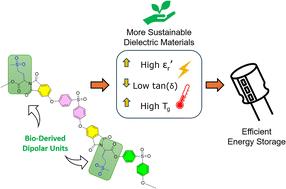Poly(ether-imide-ester)s incorporating sulfur-containing amino acids: a first step toward more sustainable high-dielectric polymer materials
IF 9.5
2区 材料科学
Q1 CHEMISTRY, PHYSICAL
引用次数: 0
Abstract
The development of high-dielectric polymer materials is critical for advancing energy storage and conversion technologies. In this study, we report the synthesis and characterization of novel poly(ether-imide-ester) (PEIE) polymers incorporating sulfur-based amino acid residues as dipolar units. Specifically, we designed and synthesized two PEIEs containing methionine (PEIE-Met) and its oxidized form, methionine sulfone (PEIE-Met(O2)), to investigate the impact of pendant thioether and sulfone groups on the dielectric properties. The synthesized polymers were thoroughly characterized via spectroscopic (FTIR, NMR), thermal (TGA, DSC), and dielectric (BDS) techniques. The results confirm the successful incorporation of methionine-based moieties into the polymer backbone, leading to the formation of materials showing high thermal stability, as evidenced by onset degradation temperatures above 300 °C, glass transition temperatures (Tg) in the 162–182 °C range, and excellent dielectric performance. Notably, at room temperature, PEIE-Met(O2) exhibited a higher dielectric constant than PEIE-Met did
than PEIE-Met did  , which was attributed to the increased dipole moment of the sulfone groups. Both polymers maintained low dielectric loss values (tan(δ) < 0.01) at room temperature, making them promising candidates for capacitor applications. Notably, the materials developed in this work exhibited discharge efficiency values above 85% at 100 °C under electric fields of 100 and 200 MV m−1, confirming their suitability as dielectric layers for energy storage applications. This study highlights the potential of bioderived amino acid residues as functional building blocks for high-dielectric polymer design. Our findings open new avenues for the development of sustainable, high-performance dielectric materials tailored for next-generation electronic and energy storage applications.
, which was attributed to the increased dipole moment of the sulfone groups. Both polymers maintained low dielectric loss values (tan(δ) < 0.01) at room temperature, making them promising candidates for capacitor applications. Notably, the materials developed in this work exhibited discharge efficiency values above 85% at 100 °C under electric fields of 100 and 200 MV m−1, confirming their suitability as dielectric layers for energy storage applications. This study highlights the potential of bioderived amino acid residues as functional building blocks for high-dielectric polymer design. Our findings open new avenues for the development of sustainable, high-performance dielectric materials tailored for next-generation electronic and energy storage applications.

含有含硫氨基酸的聚醚亚胺酯:迈向更可持续的高介电聚合物材料的第一步
高介电聚合物材料的发展对于推进能量存储和转换技术至关重要。在这项研究中,我们报道了一种新型聚醚亚胺酯(PEIE)聚合物的合成和表征,该聚合物将硫基氨基酸残基作为偶极单元。具体而言,我们设计并合成了两种含蛋氨酸(PEIE-Met)及其氧化形式蛋氨酸砜(PEIE-Met(O2))的peie,以研究垂坠的硫醚和砜基团对介电性能的影响。通过光谱(FTIR, NMR),热(TGA, DSC)和介电(BDS)技术对合成的聚合物进行了全面的表征。结果证实,基于蛋氨酸的部分成功地掺入到聚合物骨架中,形成了具有高热稳定性的材料,其起始降解温度超过300℃,玻璃化转变温度(Tg)在162-182℃范围内,并且具有优异的介电性能。值得注意的是,在室温下,PEIE-Met(O2)表现出比PEIE-Met更高的介电常数,这是由于砜基团的偶极矩增加所致。这两种聚合物在室温下保持低介电损耗值(tan(δ) < 0.01),使它们成为电容器应用的有希望的候选者。值得注意的是,本研究中开发的材料在100°C和200 MV m - 1电场下的放电效率值超过85%,证实了它们作为储能介质层的适用性。这项研究强调了生物衍生氨基酸残基作为高介电聚合物设计的功能构建块的潜力。我们的发现为开发可持续的高性能介电材料开辟了新的途径,为下一代电子和储能应用量身定制。
本文章由计算机程序翻译,如有差异,请以英文原文为准。
求助全文
约1分钟内获得全文
求助全文
来源期刊

Journal of Materials Chemistry A
CHEMISTRY, PHYSICAL-ENERGY & FUELS
CiteScore
19.50
自引率
5.00%
发文量
1892
审稿时长
1.5 months
期刊介绍:
The Journal of Materials Chemistry A, B & C covers a wide range of high-quality studies in the field of materials chemistry, with each section focusing on specific applications of the materials studied. Journal of Materials Chemistry A emphasizes applications in energy and sustainability, including topics such as artificial photosynthesis, batteries, and fuel cells. Journal of Materials Chemistry B focuses on applications in biology and medicine, while Journal of Materials Chemistry C covers applications in optical, magnetic, and electronic devices. Example topic areas within the scope of Journal of Materials Chemistry A include catalysis, green/sustainable materials, sensors, and water treatment, among others.
 求助内容:
求助内容: 应助结果提醒方式:
应助结果提醒方式:


